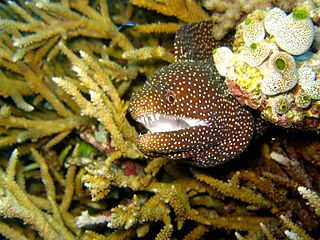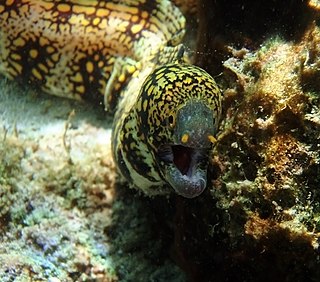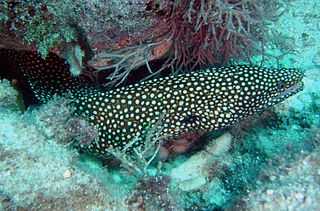
Moray eels, or Muraenidae, are a family of eels whose members are found worldwide. There are approximately 200 species in 15 genera which are almost exclusively marine, but several species are regularly seen in brackish water, and a few are found in fresh water.

Echidna is a genus of moray eels in the family Muraenidae.

The Kidako moray is a species of marine fish in the family Muraenidae. It inhabits coral reefs or lagoons and could be found in tropical and subtropical seas near Taiwan, Japan, and Australia. The species is diurnal, which means it is more active in the daytime than the nighttime. It is also piscivorous: it consumes fish, octopus, and squid. Other than the Kidako moray, there are about 200 species of moray eels in the Muraenidae family. The Kidako moray doesn't attack humans unless they are provoked. However, due to the menacing looks of the Kidako moray and moray eels in general, they are feared by divers and snorkelers.

The zebra moray is a species of marine fish in the family Muraenidae. It is the only member of the genus Gymnomuraena, though it sometimes has been included in Echidna instead.

The California moray is a moray eel of the family Muraenidae, found in the eastern Pacific from just north of Santa Barbara to Santa Maria Bay in Baja California. They are the only species of moray eel found off California, and one of the few examples of a subtropical moray. They typically occupy boulder or cobble habitats up to 40 m in depth. They can attain lengths of about 5 ft (1.52 m) and are believed to live for upwards of 22–26 years. Like other morays, they have no pelvic or pectoral fins or gill covers.

The yellow-edged moray, also known as yellow-margin(ed) moray, leopard moray, and speckled moray, is a moray eel of the family Muraenidae, found in the Indo-Pacific Oceans at depths to 150 m (500 ft).

The barred moray, also known as the banded moray, the dark-banded eel, the girdled moray, the girdled reef eel, the many banded moray eel, the ringed moray, the ringed reef moray, the striped moray and the zebra eel,) is a moray eel of the family Muraenidae. It was described by John Richardson in 1845, originally under the genus Muraena. It is a marine, tropical eel which is known from the Indo-Pacific, including the Red Sea, East Africa, the Hawaiian Islands, the Marquesan Islands, the Tuamotus Islands, the Ryukyu Islands, and the Great Barrier Reef. It dwells at a depth range of 2 to 20 metres, and leads a benthic lifestyle in reefs and shallow lagoons. Males can reach a maximum total length of 72.3 centimetres (28.5 in). It is sometimes confused with the Zebra moray (Gymnomuraena).

The turkey moray ,also known as the guineafowl moray or as the white-mouth/whitemouth moray is a species of marine fish in the family Muraenidae.

The undulated moray is a moray eel of the family Muraenidae, found in the Indo-Pacific and east-central Pacific Ocean at depths down to 30 m. Their length is up to 1.5 m.

The fimbriated moray, also known as dark-spotted moray or spot-face moray, is a moray eel of the family Muraenidae.

The fangtooth moray sometimes also known as tiger moray or bird-eye conger is a moray eel of the family Muraenidae found in warmer parts of the eastern Atlantic Ocean, including the Canary Islands, Madeira and various other islands. It entered the Mediterranean Sea from the Atlantic and is now found occasionally in the eastern Basin, from Levantine waters and off Turkey, Greece, Croatia and Sicily.

Gymnothorax melatremus, the blackspot moray, dirty yellow moray or dwarf moray, is a moray eel from the Indo-Pacific East Africa to the Marquesas and Mangaréva, north to the Hawaiian Islands, south to the Australs islands. It occasionally makes its way into the aquarium trade but still being rare to find.

Echidna catenata, commonly known as the chain moray, is a moray eel found in shallow parts of the western Atlantic Ocean and from islands elsewhere in the Atlantic. It occasionally makes its way into the aquarium trade. It grows to a maximum length of 165 cm (65 in) but a more common length is about 40 cm (16 in).
The hookjaw moray, bowmouth moray, or Bayer's moray is a moray eel of the family Muraenidae. It is found throughout the Indo-Pacific as well as in the Red Sea.
Channomuraena vittata is a rare species of moray eel from the Anguiliformes order found in reefs. It is commonly known as the broadbanded moray, banded moray, Chinese moray, double-ended moray, or the long-jawed moray.
Echidna leucotaenia, the whiteface moray, also known as the white-banded moray eel, is a moray eel. It was described by Schultz in 1943. It is a tropical, marine and freshwater eel which is known from the Indo-Pacific, including East Africa, the Line Islands, the Tuamotu Islands, and Johnston Island. It dwells at a depth range of 0 to 24 metres, and leads a benthic lifestyle in reefs. Males can reach a maximum total length of 75 centimetres (30 in).

Echidna nocturna is a moray eel found in the eastern Pacific Ocean, in the Gulf of California and around Peru and the Galapagos Islands. It was first named by Cope in 1872, and is commonly known as the freckled moray or the palenose moray. It was discovered that Echidna nocturna and Muraena acutis are the same species.

The blackcheek moray eel or masked moray is a species of marine fish in the family Muraenidae.

Gymnothorax polyuranodon, commonly known as the freshwater moray, is a species of moray eel that is native to the Indo-Pacific region, including Sri Lanka, the Philippines, Indonesia, Papua New Guinea, the northern coastline of Australia, and various islands in the western Pacific. Other common names include the many-toothed moray, spotted freshwater moray, blackspotted moray, freshwater leopard moray, and freshwater tiger moray.

The Indian mud moray eel, is a moray eel found in the western Pacific and Indian Oceans. It was first named by Hamilton in 1822, and is also commonly known as the freshwater moray or freshwater snowflake eel.



















